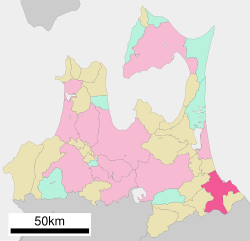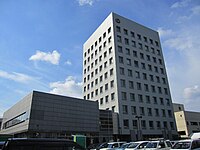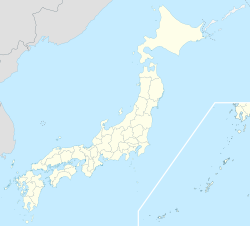
Aomori Prefecture ([a̠o̞mo̞ɾʲikẽ̞ɴ]) is a prefecture of Japan in the Tōhoku region. The prefecture's capital, largest city, and namesake is the city of Aomori. Aomori is the northernmost prefecture on Japan's main island, Honshu, and is bordered by the Pacific Ocean to the east, Iwate Prefecture to the southeast, Akita Prefecture to the southwest, the Sea of Japan to the west, and Hokkaido across the Tsugaru Strait to the north. Aomori Prefecture is the 8th-largest prefecture, with an area of 9,645.64 km2 (3,724.20 sq mi), and the 31st-most populous prefecture, with more than 1.18 million people. Approximately 45 percent of Aomori Prefecture's residents live in its two core cities, Aomori and Hachinohe, which lie on coastal plains. The majority of the prefecture is covered in forested mountain ranges, with population centers occupying valleys and plains. Aomori is the third-most populous prefecture in the Tōhoku region, after Miyagi Prefecture and Fukushima Prefecture. Mount Iwaki, an active stratovolcano, is the prefecture's highest point, at almost 1,624.7 m (5,330 ft).

Ninohe is a city located in Iwate Prefecture, Japan. As of 31 March 2020, the city had an estimated population of 26,344, and a population density of 63 persons per km2 in 11,803 households. The total area of the city is 420.42 square kilometres (162.33 sq mi).

Shingō is a village located in Aomori Prefecture, Japan. As of 28 February 2023, the village has an estimated population of 2,192 in 895 households and a population density of 15 persons per km2. The total area of the village is 150.77 square kilometres (58.21 sq mi).

Sannohe is a town located in Aomori Prefecture, Japan. As of 31 January 2023, the town had an estimated population of 9,146 in 4141 households, and a population density of 60 persons per km2. The total area of the town is 151.79 square kilometres (58.61 sq mi).

Gonohe is a town located in Aomori Prefecture, Japan. As of 1 March 2023, the town had an estimated population of 16,013 in 7027 households, and a population density of 90 persons per km2. The total area of the town is 177.67 square kilometres (68.60 sq mi).

Nanbu is a town located in Aomori Prefecture, Japan. As of 1 March 2023, the town had an estimated population of 16,885 in 7466 households, and a population density of 110 persons per km2. The total area of the town is 153.12 square kilometres (59.12 sq mi).

Hashikami is a town located in Aomori Prefecture, Japan. As of 30 April 2022, the town had an estimated population of 13,012 in 6,039 households, and a population density of 140 persons per km2 The total area of the town is 94.01 square kilometres (36.30 sq mi).

Sannohe District is a district located in Aomori Prefecture, Japan. It occupies the southeast corner of the prefecture, bordering Iwate Prefecture.

Hirono is a town located in Iwate Prefecture, Japan. As of 31 May 2024, the town had an estimated population of 14,906 I 6790 households, and a population density of 49 persons per km² in 6,858 households. The total area of the town is 302.92 km2 (116.96 sq mi).
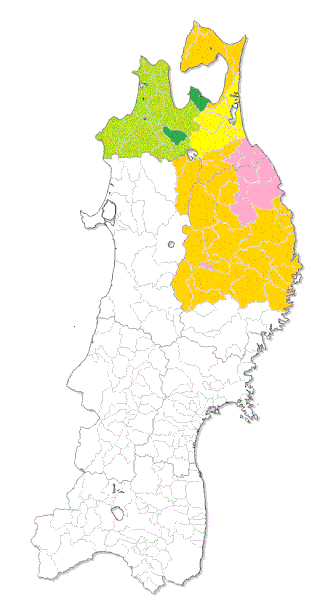
Hachinohe Domain was a tozama feudal domain of Edo period Japan It is located in Mutsu Province, in northern Honshū. The domain was centered at Hachinohe Castle, located in the center of what is now the city of Hachinohe in Aomori Prefecture.

Hachinohe Sansha Taisai (八戸三社大祭) is a Japanese festival celebrated from July 31 to August 4 in Hachinohe, Aomori Prefecture, Japan. Its rites center on three Shinto shrines: Ogami (霊神社), Shinra (新羅神社), and Shinmei (神明宮) shrines. There is a procession of twenty-seven floats and three mikoshi are also borne through the streets. It has a two hundred and ninety-year history and in 2004 was designated an Important Intangible Folk Cultural Property.
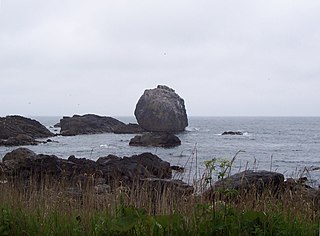
The Tanesashi Coast is section of the coastline on the Pacific Ocean, located in the southern portion of the city of Hachinohe, Aomori Prefecture, in the Tōhoku region of northern Japan. It is extends for 12 kilometres (7.5 mi) from the island of Kabushima south towards the city of Kuji in Iwate Prefecture. The coast was nationally designated a Place of Scenic Beauty in 1937.

Ne Castle is a Muromachi period Motte-and-bailey-style Japanese castle located in what is now the city of Hachinohe, Aomori Prefecture, in the Tōhoku region of far northern Japan. It has been protected by the central government as a National Historic Site since 1941. It was extensively reconstructed in 1994.

Shōjojidate Castle was a Muromachi period Japanese castle located in what is now the town of Nanbu, in Sannohe District of Aomori Prefecture, in the Tōhoku region of far northern Japan. It was also known as the Moto-Sannohe Castle. It was located at a strategic junction of the Ōshū Kaidō with the Kakuno Kaidō and the Mabechi River. The site of the castle, as well as the Buddhist temple of Sankō-ji, and the Moto-Sannohe Hachiman-gu Shinto Shrine collectively received protection as a National Historic Site on 30 September 2004. Portions of the site are now on private lands occupied by local farm houses and fruit orchards.

The Chōshichiyachi Shell Midden is an archaeological site in what is now part of the city of Hachinohe, Aomori Prefecture, in the Tōhoku region of northern Japan, with an initial Jōmon period shell midden. The site was designated a National Historic Site of Japan in 1981 by the Japanese government.

The Korekawa Site is an archaeological site in the city of Hachinohe, Aomori Prefecture, in the Tōhoku region of northern Japan containing the ruins of a middle to late Jōmon period settlement. The remains were designated a National Historic Site in 1957 by the Japanese government. It is also referred to as the "Korekawa Stone Age site", although the remains discovered are from the Jōmon period, rather than the Japanese Paleolithic period.

Korekawa Archaeological Institution , more literally the Hachinohe City Buried Cultural Property Center, opened in Hachinohe, Aomori Prefecture, Japan in 2011. It exhibits Jōmon materials from the nearby Korekawa Site and Kazahari I Site (風張1遺跡), finds at the latter including the "Palms Together Dogū" (合掌土偶) that has been designated a National Treasure.
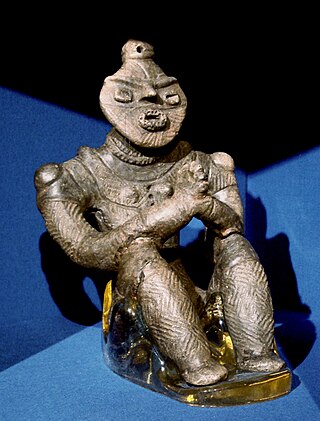
The so-called "dogū with palms pressed together" is a Japanese dogū or clay figurine of the late Jōmon period. Excavated from the Kazahari I Site in Hachinohe, Aomori Prefecture, it is exhibited at the nearby Korekawa Jōmon Kan. Alongside "Hollow Dogū" from Hokkaidō, "Jōmon Goddess" from Yamagata Prefecture, and "Jōmon Venus" and "Masked Goddess" from Nagano Prefecture, it is one of five dogū that have been designated National Treasures.

